Junyan Lin
Rethinking Visual Layer Selection in Multimodal LLMs
Apr 30, 2025Abstract:Multimodal large language models (MLLMs) have achieved impressive performance across a wide range of tasks, typically using CLIP-ViT as their visual encoder due to its strong text-image alignment capabilities. While prior studies suggest that different CLIP-ViT layers capture different types of information, with shallower layers focusing on fine visual details and deeper layers aligning more closely with textual semantics, most MLLMs still select visual features based on empirical heuristics rather than systematic analysis. In this work, we propose a Layer-wise Representation Similarity approach to group CLIP-ViT layers with similar behaviors into {shallow, middle, and deep} categories and assess their impact on MLLM performance. Building on this foundation, we revisit the visual layer selection problem in MLLMs at scale, training LLaVA-style models ranging from 1.4B to 7B parameters. Through extensive experiments across 10 datasets and 4 tasks, we find that: (1) deep layers are essential for OCR tasks; (2) shallow and middle layers substantially outperform deep layers on reasoning tasks involving counting, positioning, and object localization; (3) a lightweight fusion of features across shallow, middle, and deep layers consistently outperforms specialized fusion baselines and single-layer selections, achieving gains on 9 out of 10 datasets. Our work offers the first principled study of visual layer selection in MLLMs, laying the groundwork for deeper investigations into visual representation learning for MLLMs.
Dynamic Cross-Modal Feature Interaction Network for Hyperspectral and LiDAR Data Classification
Mar 10, 2025Abstract:Hyperspectral image (HSI) and LiDAR data joint classification is a challenging task. Existing multi-source remote sensing data classification methods often rely on human-designed frameworks for feature extraction, which heavily depend on expert knowledge. To address these limitations, we propose a novel Dynamic Cross-Modal Feature Interaction Network (DCMNet), the first framework leveraging a dynamic routing mechanism for HSI and LiDAR classification. Specifically, our approach introduces three feature interaction blocks: Bilinear Spatial Attention Block (BSAB), Bilinear Channel Attention Block (BCAB), and Integration Convolutional Block (ICB). These blocks are designed to effectively enhance spatial, spectral, and discriminative feature interactions. A multi-layer routing space with routing gates is designed to determine optimal computational paths, enabling data-dependent feature fusion. Additionally, bilinear attention mechanisms are employed to enhance feature interactions in spatial and channel representations. Extensive experiments on three public HSI and LiDAR datasets demonstrate the superiority of DCMNet over state-of-the-art methods. Our code will be available at https://github.com/oucailab/DCMNet.
Multi-Layer Visual Feature Fusion in Multimodal LLMs: Methods, Analysis, and Best Practices
Mar 08, 2025Abstract:Multimodal Large Language Models (MLLMs) have made significant advancements in recent years, with visual features playing an increasingly critical role in enhancing model performance. However, the integration of multi-layer visual features in MLLMs remains underexplored, particularly with regard to optimal layer selection and fusion strategies. Existing methods often rely on arbitrary design choices, leading to suboptimal outcomes. In this paper, we systematically investigate two core aspects of multi-layer visual feature fusion: (1) selecting the most effective visual layers and (2) identifying the best fusion approach with the language model. Our experiments reveal that while combining visual features from multiple stages improves generalization, incorporating additional features from the same stage typically leads to diminished performance. Furthermore, we find that direct fusion of multi-layer visual features at the input stage consistently yields superior and more stable performance across various configurations. We make all our code publicly available: https://github.com/EIT-NLP/Layer_Select_Fuse_for_MLLM.
Semantics Disentanglement and Composition for Versatile Codec toward both Human-eye Perception and Machine Vision Task
Dec 24, 2024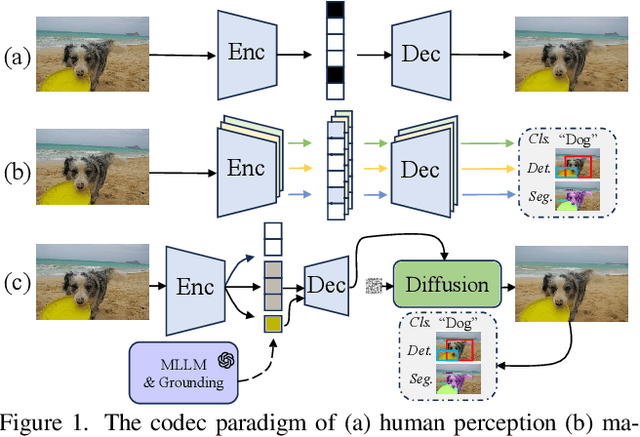



Abstract:While learned image compression methods have achieved impressive results in either human visual perception or machine vision tasks, they are often specialized only for one domain. This drawback limits their versatility and generalizability across scenarios and also requires retraining to adapt to new applications-a process that adds significant complexity and cost in real-world scenarios. In this study, we introduce an innovative semantics DISentanglement and COmposition VERsatile codec (DISCOVER) to simultaneously enhance human-eye perception and machine vision tasks. The approach derives a set of labels per task through multimodal large models, which grounding models are then applied for precise localization, enabling a comprehensive understanding and disentanglement of image components at the encoder side. At the decoding stage, a comprehensive reconstruction of the image is achieved by leveraging these encoded components alongside priors from generative models, thereby optimizing performance for both human visual perception and machine-based analytical tasks. Extensive experimental evaluations substantiate the robustness and effectiveness of DISCOVER, demonstrating superior performance in fulfilling the dual objectives of human and machine vision requirements.
To Preserve or To Compress: An In-Depth Study of Connector Selection in Multimodal Large Language Models
Oct 09, 2024



Abstract:In recent years, multimodal large language models (MLLMs) have garnered significant attention from both industry and academia. However, there is still considerable debate on constructing MLLM architectures, particularly regarding the selection of appropriate connectors for perception tasks of varying granularities. This paper systematically investigates the impact of connectors on MLLM performance. Specifically, we classify connectors into feature-preserving and feature-compressing types. Utilizing a unified classification standard, we categorize sub-tasks from three comprehensive benchmarks, MMBench, MME, and SEED-Bench, into three task types: coarse-grained perception, fine-grained perception, and reasoning, and evaluate the performance. Our findings reveal that feature-preserving connectors excel in \emph{fine-grained perception} tasks due to their ability to retain detailed visual information. In contrast, feature-compressing connectors, while less effective in fine-grained perception tasks, offer significant speed advantages and perform comparably in \emph{coarse-grained perception} and \emph{reasoning} tasks. These insights are crucial for guiding MLLM architecture design and advancing the optimization of MLLM architectures.
Tell Codec What Worth Compressing: Semantically Disentangled Image Coding for Machine with LMMs
Aug 16, 2024



Abstract:We present a new image compression paradigm to achieve ``intelligently coding for machine'' by cleverly leveraging the common sense of Large Multimodal Models (LMMs). We are motivated by the evidence that large language/multimodal models are powerful general-purpose semantics predictors for understanding the real world. Different from traditional image compression typically optimized for human eyes, the image coding for machines (ICM) framework we focus on requires the compressed bitstream to more comply with different downstream intelligent analysis tasks. To this end, we employ LMM to \textcolor{red}{tell codec what to compress}: 1) first utilize the powerful semantic understanding capability of LMMs w.r.t object grounding, identification, and importance ranking via prompts, to disentangle image content before compression, 2) and then based on these semantic priors we accordingly encode and transmit objects of the image in order with a structured bitstream. In this way, diverse vision benchmarks including image classification, object detection, instance segmentation, etc., can be well supported with such a semantically structured bitstream. We dub our method ``\textit{SDComp}'' for ``\textit{S}emantically \textit{D}isentangled \textit{Comp}ression'', and compare it with state-of-the-art codecs on a wide variety of different vision tasks. SDComp codec leads to more flexible reconstruction results, promised decoded visual quality, and a more generic/satisfactory intelligent task-supporting ability.
Sparse Focus Network for Multi-Source Remote Sensing Data Classification
Jun 03, 2024



Abstract:Multi-source remote sensing data classification has emerged as a prominent research topic with the advancement of various sensors. Existing multi-source data classification methods are susceptible to irrelevant information interference during multi-source feature extraction and fusion. To solve this issue, we propose a sparse focus network for multi-source data classification. Sparse attention is employed in Transformer block for HSI and SAR/LiDAR feature extraction, thereby the most useful self-attention values are maintained for better feature aggregation. Furthermore, cross-attention is used to enhance multi-source feature interactions, and further improves the efficiency of cross-modal feature fusion. Experimental results on the Berlin and Houston2018 datasets highlight the effectiveness of SF-Net, outperforming existing state-of-the-art methods.
Boosting Spatial-Spectral Masked Auto-Encoder Through Mining Redundant Spectra for HSI-SAR/LiDAR Classification
Jun 03, 2024Abstract:Although recent masked image modeling (MIM)-based HSI-LiDAR/SAR classification methods have gradually recognized the importance of the spectral information, they have not adequately addressed the redundancy among different spectra, resulting in information leakage during the pretraining stage. This issue directly impairs the representation ability of the model. To tackle the problem, we propose a new strategy, named Mining Redundant Spectra (MRS). Unlike randomly masking spectral bands, MRS selectively masks them by similarity to increase the reconstruction difficulty. Specifically, a random spectral band is chosen during pretraining, and the selected and highly similar bands are masked. Experimental results demonstrate that employing the MRS strategy during the pretraining stage effectively improves the accuracy of existing MIM-based methods on the Berlin and Houston 2018 datasets.
SS-MAE: Spatial-Spectral Masked Auto-Encoder for Multi-Source Remote Sensing Image Classification
Nov 08, 2023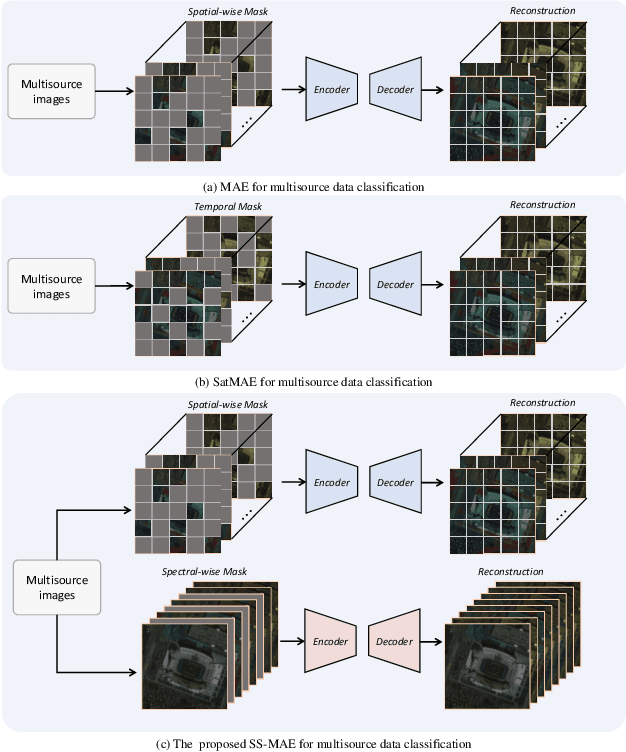
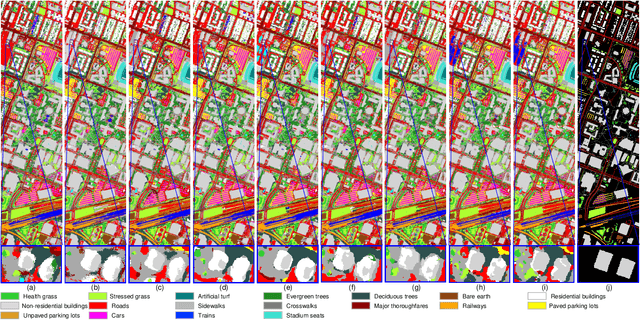
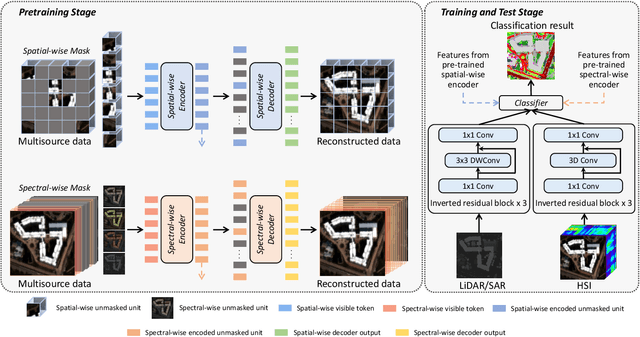
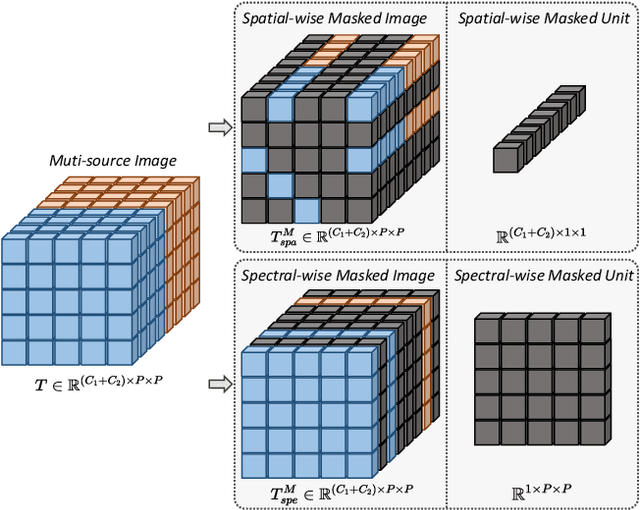
Abstract:Masked image modeling (MIM) is a highly popular and effective self-supervised learning method for image understanding. Existing MIM-based methods mostly focus on spatial feature modeling, neglecting spectral feature modeling. Meanwhile, existing MIM-based methods use Transformer for feature extraction, some local or high-frequency information may get lost. To this end, we propose a spatial-spectral masked auto-encoder (SS-MAE) for HSI and LiDAR/SAR data joint classification. Specifically, SS-MAE consists of a spatial-wise branch and a spectral-wise branch. The spatial-wise branch masks random patches and reconstructs missing pixels, while the spectral-wise branch masks random spectral channels and reconstructs missing channels. Our SS-MAE fully exploits the spatial and spectral representations of the input data. Furthermore, to complement local features in the training stage, we add two lightweight CNNs for feature extraction. Both global and local features are taken into account for feature modeling. To demonstrate the effectiveness of the proposed SS-MAE, we conduct extensive experiments on three publicly available datasets. Extensive experiments on three multi-source datasets verify the superiority of our SS-MAE compared with several state-of-the-art baselines. The source codes are available at \url{https://github.com/summitgao/SS-MAE}.
 Add to Chrome
Add to Chrome Add to Firefox
Add to Firefox Add to Edge
Add to Edge